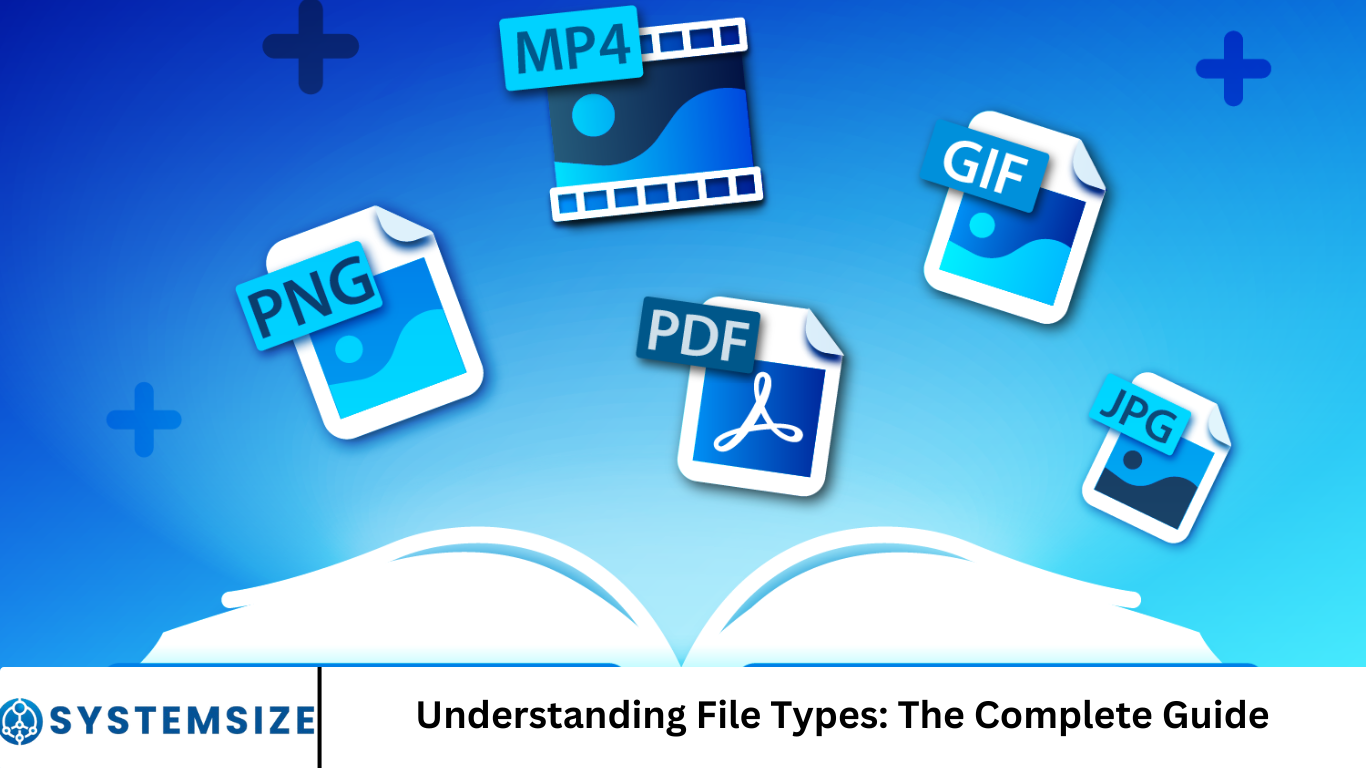In the digital world, file types (also known as file formats or file extensions) play a critical role in determining how files are stored, accessed, and shared. Whether you’re crafting a logo in Adobe Illustrator or exporting photos for the web, understanding file types is essential.
This comprehensive guide will demystify file formats, showcase best-use cases for each, and help you make informed decisions to enhance your design work, marketing assets, and digital presence.
More Read: Top 7 Disk Space Analyzers to Find Out What’s Taking Up Space on Your PC
1. What Is a File Type?
A file type is defined by its extension (like .jpg, .png, .docx), indicating its structure, encoding, and purpose. These formats influence:
- Compatibility: Which software or platform can open and edit the file
- Quality: Lossless vs. lossy compression
- Size: The resulting file footprint
- Use-Case: Web graphics, print, archival, editing, or multimedia
Keywords: file types, file formats, file extensions explained
2. Why File Types Matter in Professional Design
Choosing the right format isn’t just about compatibility—it affects:
- Visual Fidelity: Print demands high-resolution, lossless formats
- File Size & Performance: Web needs optimized, compressed images
- Editability: Layered formats like
.psdor.aikeep work editable - Workflow Efficiency: Output-ready formats streamline production
Keywords: professional design file types, file type selection, design workflow
3. Common File Types Explained
Raster (Bitmap) Formats
Raster formats store images as pixels.
- JPEG (.jpg, .jpeg)
- Pros: High compression, universal compatibility
- Cons: Lossy—degrades with repeated saves
- Use Cases: Photos, web images, email attachments
- PNG (.png)
- Pros: Lossless, supports transparency
- Cons: Larger files, slower with heavy use
- Use Cases: Logos, icons, UI elements
- GIF (.gif)
- Pros: Supports animation, small files
- Cons: Limited to 256 colors—poor for rich imagery
- Use Cases: Small animations, simple illustrations
- TIFF (.tif, .tiff)
- Pros: High quality, lossless or uncompressed
- Cons: Large files—heavy on storage
- Use Cases: Print assets, professional photography, archival
- WebP (.webp)
- Pros: Modern efficiency—impressive compression/quality
- Cons: Not fully supported by older browsers
- Use Cases: Web & mobile images
Keywords: JPEG vs PNG vs GIF, best image formats for web, raster formats
Vector Formats
Vector graphics use mathematical paths, not pixels.
- SVG (.svg)
- Pros: Scalable, editable, light weight, styled with CSS
- Cons: Not ideal for complex imagery
- Use Cases: Icons, logos, web graphics
- Adobe Illustrator (.ai)
- Pros: Native, editable, supports layers and artboards
- Cons: Requires Adobe software
- Use Cases: Logo design, branding, print
- EPS (.eps)
- Pros: Widely compatible, good for print
- Cons: Less editable; outdated features
- Use Cases: Illustration, vector print export
- PDF (.pdf)
- Pros: Portable, supports both raster and vector
- Cons: Can be large; editing layers is less intuitive
- Use Cases: Design proofs, client deliverables, print-ready documents
Keywords: vector file formats, SVG uses, AI vs EPS vs PDF
Document & Layout Formats
- DOCX (.docx)
- Used primarily by Microsoft Word for reports, proposals, etc.
- PPTX (.pptx)
- Microsoft PowerPoint format for rich presentations.
- InDesign (.indd)
- Adobe InDesign native file—ideal for multi-page layouts.
Keywords: best formats for documents, business file types
Multimedia & 3D Formats
- MP4 (.mp4) — Standard for web video
- AVI (.avi) — High-quality video, large size
- MOV (.mov) — Apple’s video, ideal for Final Cut
- MKV (.mkv) — Open-source container with high-quality paths
- MP3 (.mp3) — Most common audio format
- WAV (.wav) — High-fidelity, uncompressed audio
- FLAC (.flac) — Lossless but compressed audio
- OBJ (.obj) / FBX (.fbx) — Common 3D formats
Keywords: video and audio file types, multimedia formats explained
4. Choosing the Right File Type
Web vs. Print vs. Editability
| Purpose | Recommended Format(s) | Benefits |
|---|---|---|
| Web images | JPEG, PNG, WebP | Optimized loading, quality |
| Logos/UI | PNG, SVG | Transparency, scalability |
| Print graphics | TIFF, PDF, EPS | High fidelity, color accuracy |
| Editable files | PSD, AI, INDD | Layered work, future edits |
Keywords: web vs print file types, file type selection guide
Compression: Lossy vs Lossless
- Lossy (JPEG, MP3): Great compression—some quality lost
- Lossless (PNG, WAV): Full fidelity—larger files
- Choosing Wisely: Web favors lossy; professional use favors lossless
Keywords: lossy vs lossless, image compression for design
Transparency & Backgrounds
- PNG & SVG: Support transparency
- JPEG: No transparency
- EPS/PDF: Can include transparent regions with support
Keywords: transparent image file types, PNG vs JPEG background
5. Real‑World Examples & Best Practices
Web Graphic: Hero Banner
- Export as JPEG for vivid photos
- Use WebP for superior compression if browser support is good
- Overlay text and UI elements
Logo & Branding
- Create in AI or SVG for scalability
- Export PNG with transparency for web
- Provide PDF + EPS for print vendors
Marketing Collateral (Brochures, Flyers)
- Design in InDesign or Illustrator
- Export final print files as PDF/X‑1a or TIFF with CMYK color profile
Social Media Graphics
- Save as PNG for crisp text and icons
- Resize to platform specs (e.g., 1080×1080 for Instagram)
- Use WebP/JPEG if file size is critical
Keywords: file types for social media, print collateral formats
6. Tools & Tips for File Conversion
Best Software
- Adobe Photoshop / Illustrator / InDesign
- Affinity Suite (Designer, Photo, Publisher)
- GIMP / Inkscape (free and open-source alternatives)
Online Converters & Batch Tools
- CloudConvert, Zamzar, TinyPNG – for image formats
- ExifTool, ImageMagick – command-line batch processing
- VideoProc, FFmpeg – multimedia format handling
Keywords: file converter tools, batch image conversion tips
7. Common Pitfalls & How to Avoid Them
- Quality loss from JPEG recompression: Use
Save As…carefully - Wrong color mode for print: Use CMYK in PDF/TIFF exports
- Oversized web images: Scale before exporting
- Missing fonts: Embed or convert fonts to outlines in print-ready PDFs
Keywords: avoid file format mistakes, design workflow troubleshooting
8. SEO & Performance Optimization Tips
- Always include alt attributes on web images
- Use responsive formats like WebP for web speed
- Provide multiple resolutions (
1x,2x) for retina displays - Lazy-load large files to improve page speed
Keywords: optimize web images, SEO for file types, responsive image formats
9. Future Trends in File Formats
- WebP and AVIF are gaining traction for efficiency
- Vector-first design (more SVG usage in UI)
- Cloud-native formats: Figma, Adobe XD files (non-exportable binary formats)
- 3D/AR formats: glTF (GL Transmission Format) becoming standard for AR environments
Keywords: future file formats, emerging file types, webfont future
10. How ExtraDigital Approaches File Formats
At ExtraDigital, we tailor file type selection based on:
- Client goals (web performance vs. print excellence)
- Brand consistency across platforms
- Workflow efficiencies and red-line control
- Search engine needs (image sitemaps, page speed)
We offer:
- File planning docs mapping deliverables to formats
- Template libraries (AI, PSD, IDML files)
- Automated export scripts for WebP and retina assets
- Training sessions to minimize mistakes
Frequently Asked Question
What is the difference between raster and vector file types?
Raster files (like JPEG and PNG) are made of pixels and are resolution-dependent, which means they can lose quality when scaled. Vector files (like SVG and AI) are based on paths and shapes, making them scalable without any loss of quality—ideal for logos and illustrations.
Which file type is best for web images?
JPEG, PNG, and WebP are the most common web image formats. JPEG is great for photos, PNG for images needing transparency, and WebP offers superior compression with good quality—perfect for fast-loading websites.
What file format should I use for printing high-quality designs?
For print, use TIFF, PDF, or EPS formats. These support high resolution, CMYK color profiles, and are widely accepted by professional printers.
Why does image quality decrease when I save a JPEG multiple times?
JPEG uses lossy compression, which permanently discards some data each time the image is saved. This leads to gradual quality loss. To avoid this, edit in a lossless format (like PSD or TIFF), and only export to JPEG once.
What’s the best format for creating logos?
Use AI (Adobe Illustrator) or SVG for creating logos. These vector formats allow infinite scalability and precise editing. Export as PNG or PDF for web and print use.
Can I convert one file type to another without losing quality?
It depends on the file types. Converting from a lossless format (like PNG to TIFF) usually retains quality, but converting from lossy (like JPEG to PNG) won’t restore lost data. Always keep an editable master file (e.g., PSD, AI) for future exports.
What is the difference between PDF and EPS files?
Both are used for sharing graphics and print-ready content. PDF is more versatile, supporting vector and raster elements, interactivity, and embedding fonts. EPS is older and primarily used for vector graphics in print workflows. PDF is generally preferred for modern use.
Conclusion
Mastering file types is a foundational skill every creative professional needs. This guide has walked you through key formats, use cases, and best practices—from raster and vector to multimedia and advanced web formats. Whether you’re preparing assets for clients or launching global campaigns, selecting the right format saves time, enhances quality, and boosts performance. Armed with this knowledge, plus practical tips from ExtraDigital, you’re ready to elevate your design assets like a pro.


